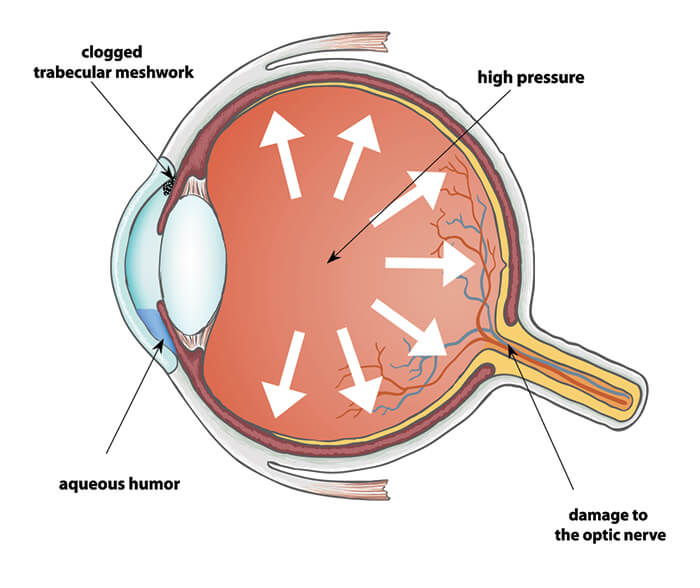Glaucoma
Glaucoma is a vision-threatening disease that can cause optic nerve damage, most often from high pressure caused by poor drainage of fluid (aqueous humor), which supplies nutrients to the cornea and lens. Glaucoma is one of the leading causes of vision loss and involves progressive and irreversible damage to the optic nerve.

Diagram of Glaucoma

Example of Glaucoma Vision Loss
The Most Common Types of Glaucoma are:
Open-Angle Glaucoma is the most common type that occurs in approximately 90 percent of those who suffer from the disease. This condition can develop gradually and be undetected for years, slowly damaging vision.
- A gradual loss of peripheral vision, usually in both eyes
- Tunnel vision in the advanced stages
Chronic Closed-Angle Glaucoma is less common than Open-Angle Glaucoma but is a chronic condition also that can go undetected for years and permanently damage the vision. Signs and symptoms are similar to Open-Angle Glaucoma.
Acute Angle Closure Glaucoma or Acute Closed Angle Glaucoma is an eye emergency which is much more rapid in the onset and affects less than ten percent of glaucoma patients. Symptoms occur suddenly and are much more severe, but vision can be preserved with prompt, effective treatment.
- Severe Eye Pain
- Nausea and vomiting ( accompanying the severe eye pain )
- Sudden onset of visual disturbance, often in low light and at night
- Blurred Vision
- Halos around lights
- Reddening of the eye
Glaucoma Causes

In open-angle glaucoma, the drainage channels in the angle (called the trabecular meshwork) are partially blocked, causing the aqueous humor to drain out of the eye too slowly. The exact cause of open-angle glaucoma remains unknown. Closed-angle glaucoma occurs when the iris protrudes forward to narrow or block the drainage angle formed by the cornea and the iris. As a result, aqueous fluid can no longer reach the trabecular meshwork at the angle and the eye pressure increases. Sometimes, glaucoma can be traced to a known cause, such as eye injury, inflammation, tumor, advanced cataract or diabetes.
Treatment Options for Glaucoma:
Fortunately, glaucoma is highly treatable. The key to preventing serious vision loss or blindness from glaucoma is early detection. An annual fully dilated eye examination is recommended. Treatment involves medications, laser procedures and/or surgery to lower internal eye pressure by opening drainage passageways for the trapped fluid.
In the early stages of open-angle glaucoma, medicated eye drops are usually prescribed to lower the eye’s pressure. If the condition worsens, a laser procedure called a trabeculoplasty is performed to lower pressure further. Laser therapy usually takes approximately 10 minutes and has achieved excellent success rates in select patients. The treatment for angle-closure glaucoma, or narrow-angle glaucoma, is generally initiated with laser iridotomy to open the drainage channels of the eye.





